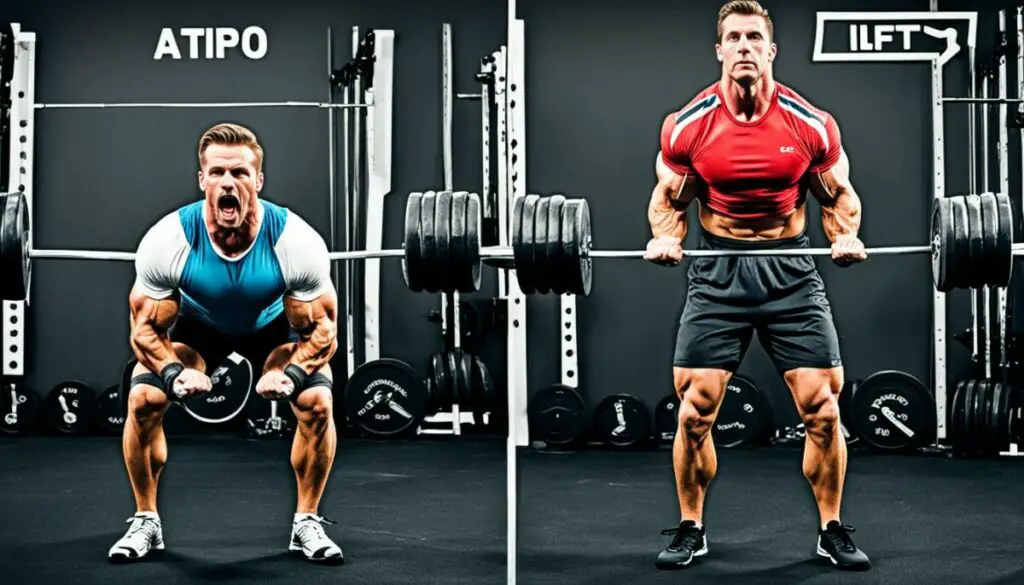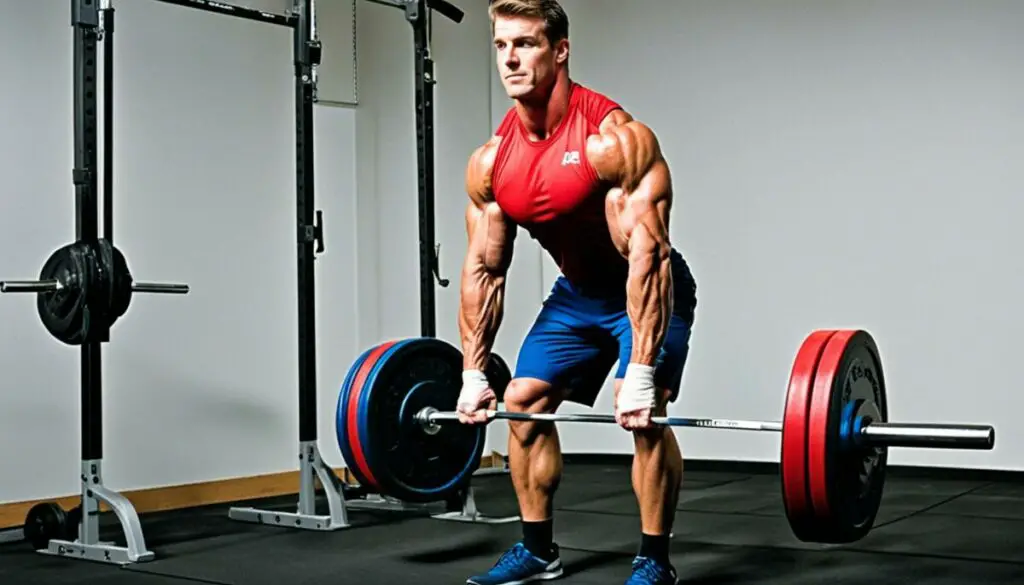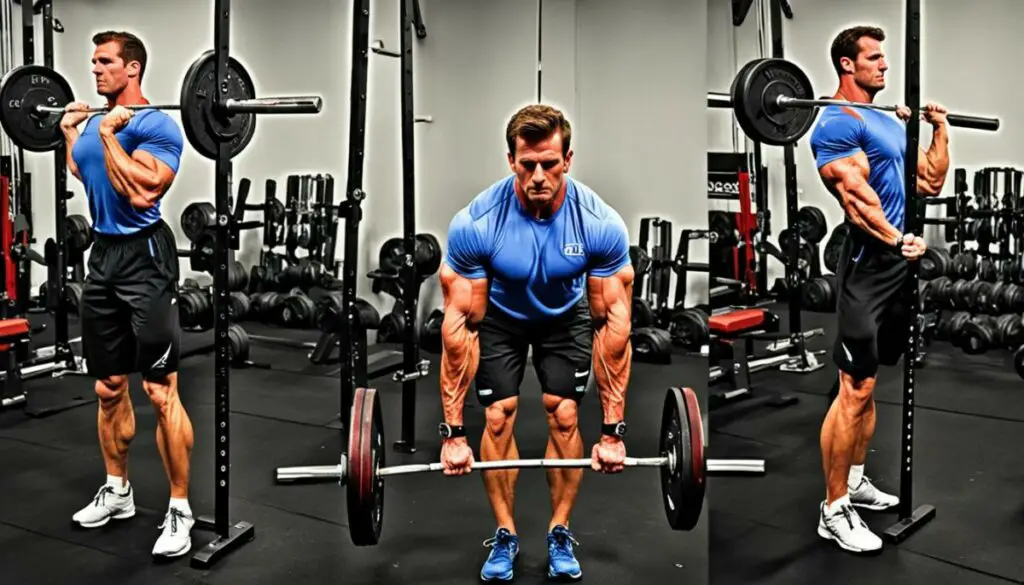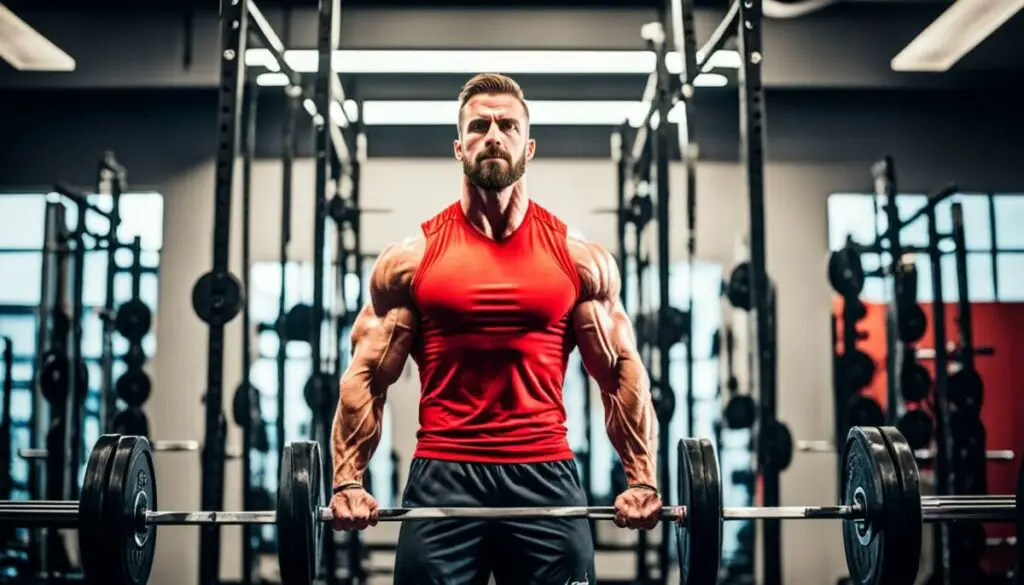Last Updated on 3 months by Francis
Deadlifts are a popular exercise for building strength, but trap bar deadlifts offer unique benefits for speed, quad development, and safety. In this guide, we will explore everything you need to know about trap bar deadlifts, including the muscles worked and how to perform the exercise correctly.
Contents
Key Takeaways:
- Trap bar deadlifts target multiple muscle groups, including the glutes, hamstrings, quadriceps, erector spinae, and traps and lats.
- Trap bar deadlifts provide a safer alternative to conventional deadlifts, reducing the risk of lower back injuries.
- Trap bar deadlifts are ideal for beginners and individuals with lower back issues.
- Proper form and technique are crucial when performing trap bar deadlifts to maximize their benefits.
- Incorporate trap bar deadlifts into your training routine to improve strength and muscle development.
What Are Trap Bar Deadlifts?

Trap bar deadlifts are a variation of the conventional deadlift that utilizes a hexagonal-shaped trap bar. This unique design allows you to step inside the bar and lift the weight, providing a different range of motion and targeting specific muscle groups. Trap bar deadlifts offer a variety of exercises and variations that can be incorporated into your training routine to enhance your strength and overall fitness.
Trap Bar Deadlift Exercises and Variations
There are numerous trap bar deadlift exercises and variations you can incorporate into your workouts. These variations target different muscle groups and can help you to progress in your strength training goals. Some popular trap bar deadlift exercises and variations include:
- Rack Pulls: This exercise focuses on targeting the upper body and back muscles by lifting the bar from knee height.
- Single-Leg Trap Bar Deadlifts: This variation challenges your balance and stability by performing the exercise on one leg, targeting the glutes, hamstrings, and core.
- Sumo Trap Bar Deadlifts: This wide stance variation places additional emphasis on the inner thighs and glutes.
Trap Bar Deadlift Technique
Proper technique is crucial when performing trap bar deadlifts to ensure optimal results and reduce the risk of injury. Here are some key pointers for correct trap bar deadlift technique:
- Position yourself in the center of the trap bar with your feet shoulder-width apart and toes pointed slightly outwards.
- Engage your core and maintain a neutral spine throughout the lift.
- Grip the handles with a firm grip, keeping your wrists straight.
- Hinge at the hips and bend your knees, maintaining a squat-like position.
- Drive through your heels and extend your hips, standing up to a fully upright position.
- Lower the trap bar back to the starting position in a controlled manner, maintaining proper form.
Remember to start with lighter weights and gradually increase the load as you become comfortable with the exercise. It’s always advisable to consult with a qualified fitness professional to ensure you are performing trap bar deadlifts with proper technique and form.
Differences Between Trap Bar and Conventional Deadlifts

Trap bar deadlifts and conventional deadlifts have distinct differences in terms of equipment, range of motion, and injury risk. Understanding these disparities can help you choose the right deadlift variation for your fitness goals and abilities.
Trap bar deadlifts differ from conventional deadlifts in several ways. Firstly, the trap bar requires a different type of barbell with a hexagonal shape, while conventional deadlifts use a straight Olympic barbell. The hexagonal shape of the trap bar allows the lifter to step inside, providing a more balanced and comfortable grip.
One major difference between trap bar and conventional deadlifts is the range of motion. Due to the handle positioning, trap bar deadlifts have a shorter range of motion compared to conventional deadlifts. This means that the starting position of the lift is typically higher, reducing the stress on the lower back while still targeting the same muscle groups.
Another significant difference is the learning curve and injury risk. Trap bar deadlifts are often considered easier to learn and execute correctly compared to conventional deadlifts. The trap bar’s design allows for a more neutral and upright torso position, reducing the risk of rounding the back and putting excess strain on the spine.
Overall, trap bar deadlifts are a great alternative for individuals who may struggle with conventional deadlift form or have concerns about lower back stress. It is essential to note that both deadlift variations offer unique benefits, and the choice between them depends on your specific fitness goals and personal preferences.
Key Differences Between Trap Bar and Conventional Deadlifts:
- Equipment: Trap bar deadlifts use a hexagonal-shaped trap bar, while conventional deadlifts utilize a straight Olympic barbell.
- Range of Motion: Trap bar deadlifts have a shorter range of motion due to handle positioning, resulting in a higher starting position.
- Learning Curve and Injury Risk: Trap bar deadlifts are generally easier to learn and have a lower risk of injury compared to conventional deadlifts.
How to Perform a Trap Bar Deadlift

Performing a trap bar deadlift correctly is essential to maximize its benefits and minimize the risk of injury. Follow these steps to ensure proper form and technique:
Step 1: Set Up the Weight and Position Yourself
Begin by setting up the desired weight on the trap bar. Step inside the barbell, ensuring that your feet are shoulder-width apart.
Step 2: Grip the Handles
Grab the handles of the trap bar using an overhand grip. Your palms should be facing your body.
Step 3: Hinge at the Hips
With a slight bend in your knees, hinge at the hips and push your glutes back. Maintain a straight back and avoid rounding your shoulders.
Step 4: Squat Down
Lower your body into a squat position, ensuring that your thighs are parallel to the floor. Keep your chest up and your core engaged.
Step 5: Push the Floor Away
Push through your feet and drive the floor away. Extend your hips, straighten your legs, and stand up, all while maintaining an upright torso.
Step 6: Lower the Barbell
Slowly lower the barbell back to the starting position, maintaining control and keeping your back straight throughout the movement.
Remember, proper trap bar deadlift form and technique are crucial for safety and effectiveness. Keeping your core tight, engaging the correct muscle groups, and avoiding excessive rounding or arching of your back will help you perform this exercise correctly.
Check out the image below for a visual guide on trap bar deadlift form:
Common Mistakes and Benefits of Trap Bar Deadlifts
When performing trap bar deadlifts, it’s important to be aware of common mistakes that can hinder your progress. Two of the most common faults are knees caving in and rounding the back during the movement. These errors can compromise your form and increase the risk of injury.
To avoid knees caving in, focus on actively driving your knees outwards throughout the lift. This helps engage the proper muscles and maintain a stable base of support. Additionally, it’s crucial to maintain a strong and upright posture throughout the exercise to prevent rounding of the back.
“Proper form is essential for getting the most out of trap bar deadlifts and minimizing the risk of injury. By correcting these common mistakes, you can optimize your performance and maximize the benefits.”
Now, let’s explore the numerous benefits that trap bar deadlifts offer:
- Ideal for beginners: Trap bar deadlifts are a great starting point for individuals new to strength training. The hexagonal shape of the bar provides improved stability, making it easier to learn the movement.
- More quad muscle activation: Compared to conventional deadlifts, trap bar deadlifts place a greater emphasis on the quadriceps (front thighs). This makes them an excellent choice for individuals looking to develop strong and defined quadriceps.
- Safe for the spine: The trap bar deadlift offers a more upright torso position compared to conventional deadlifts, reducing the stress on the lower back. This makes it a safer option for individuals with lower back issues or those concerned about spinal loading.
- Improved speed and power output: Trap bar deadlifts can enhance your speed and power capabilities by targeting multiple muscle groups simultaneously. This translates into improved athletic performance and explosiveness.
By addressing common mistakes and capitalizing on the unique benefits of trap bar deadlifts, you can effectively incorporate this exercise into your training routine and reap its rewards.
Muscles Worked in a Trap Bar Deadlift

The trap bar deadlift is a compound exercise that engages multiple muscle groups in the body. When performed correctly, it targets the following primary muscles:
- Glutes: The gluteus maximus, medius, and minimus are activated to extend the hips during the upward phase of the lift, providing power and stability.
- Hamstrings: The hamstrings, including the biceps femoris, semitendinosus, and semimembranosus, play a crucial role in hip extension and knee flexion during the lift.
- Quadriceps: The quadriceps muscles, including the rectus femoris, vastus lateralis, vastus medialis, and vastus intermedius, work to extend the knees as you stand upright with the weight.
- Erector Spinae (Lower Back): The erector spinae muscles, which run along the length of the spine, help stabilize the trunk and maintain an upright posture throughout the movement.
- Traps and Lats: The trapezius and latissimus dorsi muscles are engaged to stabilize the shoulders and upper back during the lift.
By targeting these muscle groups, the trap bar deadlift provides a comprehensive full-body workout that promotes strength, power, and functional fitness.
Beyond the Primary Muscles
In addition to the primary muscles worked, trap bar deadlifts also involve synergistic muscles that provide support and stability throughout the movement. These include:
- Core muscles: The abdominals and obliques engage to maintain a stable torso and resist excessive spinal flexion or extension.
- Grip and forearm muscles: The muscles in the hands, wrists, and forearms are activated to maintain a secure grip on the barbell.
- Calf muscles: The calves contribute to stabilizing the ankles and assisting in the extension of the ankles and knees during the lift.
The involvement of these synergistic muscles adds an extra dimension to the trap bar deadlift, making it a highly effective exercise for overall strength and muscle development.
“The trap bar deadlift is a powerhouse exercise that engages multiple muscle groups, making it a time-efficient and highly effective choice for those looking to build total-body strength and muscle mass.”
| Muscle Group | Primary Muscles Engaged | Synergistic Muscles Involved |
|---|---|---|
| Glutes | Gluteus maximus, medius, minimus | Core muscles, calves |
| Hamstrings | Biceps femoris, semitendinosus, semimembranosus | Core muscles, calves |
| Quadriceps | Rectus femoris, vastus lateralis, vastus medialis, vastus intermedius | Core muscles, calves |
| Erector Spinae (Lower Back) | Erector spinae | Core muscles |
| Traps and Lats | Trapezius, latissimus dorsi | Forearms, grip muscles |
Training Tips and Sample Workouts

To incorporate trap bar deadlifts into your training, it’s important to start with lighter weights and focus on proper form and technique. This will help you to build a solid foundation and prevent any potential injuries. As you become more comfortable and stronger, you can gradually increase the weight.
Here are some training tips to keep in mind:
- Familiarize yourself with the trap bar: Before jumping into the exercise, take some time to get comfortable with the trap bar. Practice your grip, find your ideal stance, and ensure that your body is properly aligned.
- Engage your core: Throughout the movement, make sure to engage your core muscles by bracing them. This will help you maintain a stable and controlled lift.
- Initiate the movement from the hips: The trap bar deadlift is a hip-dominant exercise, so it’s important to initiate the movement by pushing your hips back. This will ensure that you’re properly engaging your glutes and hamstrings.
- Keep your back straight: Maintain a neutral spine throughout the exercise. Avoid rounding or arching your back, as this can put unnecessary stress on your spine.
- Breathe correctly: Remember to inhale before starting the lift and exhale as you push through the movement. Proper breathing technique will help you maintain stability and generate power.
Now let’s take a look at some sample workouts that incorporate trap bar deadlifts:
Sample Workout 1: Full Body Strength
| Exercise | Sets | Reps |
|---|---|---|
| Trap Bar Deadlift | 3 | 8-10 |
| Barbell Bench Press | 3 | 8-10 |
| Dumbbell Rows | 3 | 10-12 |
| Dumbbell Shoulder Press | 3 | 8-10 |
| Walking Lunges | 3 | 10-12 per leg |
Rest for 60-90 seconds between sets and adjust the weight according to your own fitness level.
Sample Workout 2: Lower Body Focus
| Exercise | Sets | Reps |
|---|---|---|
| Trap Bar Deadlift | 4 | 6-8 |
| Barbell Squat | 3 | 8-10 |
| Single-Leg Romanian Deadlift | 3 | 10-12 per leg |
| Glute Bridge | 3 | 12-15 |
| Seated Calf Raises | 3 | 12-15 |
Rest for 60-90 seconds between sets and adjust the weight according to your own fitness level.
Remember, these sample workouts are just a starting point. Feel free to customize them based on your own goals and preferences. Experiment with different variations of the trap bar deadlift, such as deficit deadlifts or sumo deadlifts, to challenge your muscles in new ways and keep your workouts interesting.
Trap Bar Deadlift vs Straight Bar Deadlift
The trap bar deadlift and straight bar deadlift are two popular variations of the deadlift exercise. While both exercises target similar muscle groups and have benefits for strength and muscle development, they do have key differences in range of motion, muscle activation, and overall feel.
The trap bar deadlift, also known as the hex bar deadlift, involves using a hexagonal-shaped barbell with handles on the sides. This unique design allows you to step inside the barbell and lift the weight. On the other hand, the straight bar deadlift uses a traditional straight Olympic barbell.
One of the main differences between the two exercises is the range of motion. Due to the handle positioning in the trap bar deadlift, the range of motion is shorter compared to the straight bar deadlift. This can be beneficial for individuals with limited mobility or those recovering from injuries.
Another difference is the muscle activation. While both exercises target muscles such as the glutes, hamstrings, and quadriceps, the trap bar deadlift tends to place more emphasis on the quadriceps compared to the straight bar deadlift. This is because the trap bar deadlift allows for a more upright torso position, shifting the load to the front of the body.
In terms of overall feel, the trap bar deadlift is often considered easier to learn and has a lower risk of injury compared to the straight bar deadlift. This is due to the neutral grip and the more natural movement pattern of the trap bar deadlift, which can be more comfortable for beginners and individuals with lower back issues.
Despite these differences, both the trap bar deadlift and straight bar deadlift can be effective exercises for building strength and muscle mass. The choice between the two exercises ultimately depends on individual goals and preferences.
| Trap Bar Deadlift | Straight Bar Deadlift |
|---|---|
| Easier to learn | Greater range of motion |
| Lower risk of injury | Targets more lower back muscles |
| Places emphasis on quadriceps | Places more emphasis on glutes and hamstrings |
| More natural movement pattern | Traditional movement pattern |
Who Should Do Trap Bar Deadlifts
Trap bar deadlifts are a versatile exercise that can benefit individuals of all fitness levels. They are suitable for a wide range of people, including beginners, athletes, and experienced lifters. Whether you’re looking to build strength, improve athletic performance, or develop muscle mass, trap bar deadlifts can be a valuable addition to your training routine.
For beginners, trap bar deadlifts provide a comfortable and easier alternative to conventional deadlifts. The hexagonal shape of the trap bar allows for a more natural lifting position, reducing the strain on the lower back and making it easier to learn the proper technique. This can be particularly beneficial for individuals with lower back issues who may find conventional deadlifts challenging.
Athletes can also benefit from incorporating trap bar deadlifts into their training program. The exercise targets multiple muscle groups, including the glutes, hamstrings, quadriceps, erector spinae (lower back), and traps and lats. By strengthening these muscles, athletes can improve their power, speed, and overall athletic performance.
Quote: “Trap bar deadlifts are a great exercise for athletes of all sports. They help develop explosive power, improve acceleration and deceleration, and enhance overall strength and stability.” – Coach Smith, Strength and Conditioning Specialist
Experienced lifters can also benefit from trap bar deadlifts as a variation in their training routine. The exercise allows for heavier loads compared to other deadlift variations, making it an effective strength-building exercise. It also provides a unique stimulus to the muscles, offering a fresh challenge and promoting muscle growth.
Whether you’re a beginner, an athlete, or an experienced lifter, incorporating trap bar deadlifts into your training can help you achieve your fitness goals. Remember to start with lighter weights and focus on proper form and technique. Gradually increase the weight as you become more comfortable and stronger.
Check out the table below for a summary of who should do trap bar deadlifts:
| Who Should Do Trap Bar Deadlifts: |
|---|
| Beginners |
| Athletes |
| Experienced Lifters |
| Individuals with lower back issues |
Incorporate trap bar deadlifts into your training routine and experience the benefits they can provide in building strength, improving performance, and developing muscle mass.
Conclusion
Incorporating trap bar deadlifts into your training routine can be highly advantageous for building strength and muscle mass. This versatile exercise targets multiple muscle groups, including the glutes, hamstrings, quadriceps, erector spinae, traps, and lats. By engaging these muscles, trap bar deadlifts promote overall strength and stability in the body.
One of the significant benefits of trap bar deadlifts is that they offer a safer alternative to conventional deadlifts. The unique design of the trap bar reduces the risk of injury, particularly to the lower back, making it an excellent choice for individuals with back issues or beginners who are new to the exercise.
Regardless of your fitness level or goals, incorporating trap bar deadlifts into your training routine can lead to noticeable gains in strength and muscle development. Whether you are an athlete looking to improve performance or a beginner aiming to build strength, the trap bar deadlift can be an invaluable addition to your workout regimen.
FAQ
What muscles does the trap bar deadlift work?
The trap bar deadlift targets multiple muscle groups, including the glutes, hamstrings, quadriceps, erector spinae (lower back), and traps and lats.
What are trap bar deadlifts?
Trap bar deadlifts are a variation of the conventional deadlift that use a hexagonal-shaped trap bar. They offer unique benefits for speed, quad development, and safety.
What are the differences between trap bar deadlifts and conventional deadlifts?
Trap bar deadlifts use a different type of barbell with a hexagonal shape, have a shorter range of motion, and are considered easier to learn with a lower risk of injury compared to conventional deadlifts.
How do you perform a trap bar deadlift?
To perform a trap bar deadlift, step inside the bar, set your stance, and grip the handles. Hinge at the hips, squat down, maintain an upright torso, push the floor away, stand up, and then lower the barbell to the floor with control.
What are common mistakes and benefits of trap bar deadlifts?
Common mistakes in trap bar deadlifts include knees caving in and rounding the back, which can be fixed by driving the knees outward and maintaining an upright posture. The benefits of trap bar deadlifts include being ideal for beginners, activating more quad muscles, being safer for the spine, and improving speed and power output.
What muscles are worked during a trap bar deadlift?
The primary muscles worked during a trap bar deadlift include the glutes, hamstrings, quadriceps, erector spinae (lower back), and traps and lats. These muscles are engaged throughout the movement to lift the weight and stabilize the body.
What are some training tips and sample workouts for trap bar deadlifts?
When incorporating trap bar deadlifts into your training, start with lighter weights and focus on proper form and technique. Gradually increase the weight as you become more comfortable and stronger. Sample workouts can include variations of trap bar deadlifts, such as single-leg deadlifts or deficit deadlifts, to challenge different muscle groups and increase overall strength.
How do trap bar deadlifts compare to straight bar deadlifts?
Trap bar deadlifts are considered easier to learn and have a lower risk of injury compared to straight bar deadlifts. However, both exercises provide benefits for building strength and muscle mass, and individuals may choose one or the other based on their goals and preferences.
Who should do trap bar deadlifts?
Trap bar deadlifts are suitable for a wide range of individuals, including beginners, athletes, and experienced lifters. They can be a valuable exercise for building strength, improving athletic performance, and developing muscle mass. Beginners and individuals with lower back issues may find trap bar deadlifts more comfortable and easier to learn compared to conventional deadlifts.
Is there any conclusion about trap bar deadlifts?
There is no specific conclusion about trap bar deadlifts at this time.








